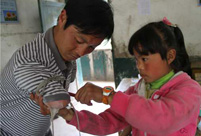Expanding community-level democracy in both urban and rural Tibet
In China community-level democracy is an effective way of ensuring that the people are masters of their own country, and an important way of expanding the political participation of China's citizens. After years of exploration, Tibet has put in place a system of community-level democracy covering both farming and pastoral areas with Chinese and Tibetan characteristics. In Tibet, the villagers' self-governance system and the system of regional ethnic autonomy have helped institutionalize and regulate community-level democracy, guaranteed the people's rights to participate in and discuss state and regional affairs, and aroused their enthusiasm for political participation. On July 5, 1959 a total of 443 peasants of Khesum Village in the Shannan region founded the first association of peasants in Tibet, starting the building of community-level democracy in Tibet. In 1993 Tibet published the Measures for the Tibetan Autonomous Region' s Implementation of the Law of Organizing the Villagers' Committees of the People's Republic of China (For Trial Implementation), ensuring that the election of villagers' committees around the region is conducted according to due procedures. Currently, over 95 percent of the villages in Tibet have established the system of villagers' representative meetings. A democratic management system mainly consisting of village regulations, code of conduct for villagers and self-governance rules, as well as a democratic supervision system that requires village affairs be made known to all villagers are being improved. All villages now make village affairs public and exercise democratic management; and over 90 percent of the villages in Tibet have set up billboards, ensuring the ordinary people's rights to be informed, to participate, to decide and to supervise. During the seventh general election of village (community) committees of Tibet, 1,686,800 people registered, and 1,495,000 voted, making a turnout rate of 88.7 percent; and 26,335 were elected to village or community committees. Community-level democracy has been improving. Tibet's 192 urban communities have all set up community residents' congresses and community committees, providing a solid organizational guarantee for the self-governance of local residents.
Establishing and cementing a new ethnic relationship
In the Tibet Autonomous Region there are over 40 ethnic groups, including those of the Tibetan, Han, Hui, Moinba, Lhoba, Naxi, Sherpa and Deng, with the Tibetan group making up the majority of the population. During the long history of Tibet, these peoples jointly developed the Tibetan Plateau and created the history of Tibet, making it an important part of the history of the Chinese nation. After the People's Republic of China was founded in 1949, the Central Government carried out an ethnic policy that stresses ethnic equality and unity, regional ethnic autonomy and the common prosperity of all ethnic groups. For over 60 years since its peaceful liberation, Tibet has fully carried out the state ethnic policy, removing political, economic and social factors that would have resulted in ethnic inequality, while eliminating the class differences and personal bondage relations peculiar to Tibet; thus, it has established a new socialist ethnic relationship featuring equality, unity, mutual-aid and harmony.
Driven by the growing socialist market economy, population movements have become more and more frequent between Tibet and the rest of China, between the Tibetan group and other ethnic groups, and within Tibet; mutual exchanges, tolerance and fusion between ethnic groups has become the mainstream of the ethnic relationship. While people of all ethnic groups go to Tibet for business, work, exchanges, pilgrimages and tourism, numerous Tibetan people leave Tibet and the Tibetan-inhabited areas in Sichuan, Yunnan, Gansu and Qinghai provinces, and go to inland cities for business, work, study, exchanges and tourism. The China Tibetology Research Center conducted a research in 2011 to study the migration of Tibetan population in inland China. It found that there are different numbers of Tibetan people, floating or resident, in Beijing, Shanghai, Chengdu, Guangzhou, Xining, Lanzhou, Kunming and other big cities. For example, in the city proper of Chengdu there is a Tibetan population of over 30,000 with registered permanent residence, and 150,000 to 200,000 without registered permanent residence. In addition, areas where Tibetans live in compact communities have appeared in some of the counties and urban districts of Chengdu. The People's Government of the Tibet Autonomous Region has worked hard to educate local people about ethnic unity. It holds a theme campaign every September to increase awareness of ethnic unity. Every year there is a conference for the commendations of those who have been outstanding in promoting ethnic unity and progress. Many other activities are also organized by the government to promote this theme.
【11】 【12】 【13】 【14】 【15】 【16】 【17】 【18】 【19】 【20】
【21】 【22】 【23】


 No news of survivors in Lao Airlines crash
No news of survivors in Lao Airlines crash Five fighters in flight training
Five fighters in flight training London mayor hails free trade, subway system on China tour
London mayor hails free trade, subway system on China tour Different eye catching shows at housing fairs in China
Different eye catching shows at housing fairs in China Chalk it up to great courage
Chalk it up to great courage Tibetan girl helps mobilize volunteers onlin
Tibetan girl helps mobilize volunteers onlin Lingerie show dazzles Wuhan Motor Show 2013
Lingerie show dazzles Wuhan Motor Show 2013  Chinese screen goddesses from Beijing Film Academy
Chinese screen goddesses from Beijing Film Academy  Weekly Sports Photos
Weekly Sports Photos Bayi Parachute Team of PLA Air Force
Bayi Parachute Team of PLA Air Force World has never been dark-- a blind kid’s life in Tibet
World has never been dark-- a blind kid’s life in Tibet Change to law may make it easier to sue polluters
Change to law may make it easier to sue polluters UNESCO world heritage site: Montale Tower
UNESCO world heritage site: Montale Tower U.S. Senate leader announces bipartisan deal
U.S. Senate leader announces bipartisan deal Fiber-optic wedding dress show shinning in Suzhou
Fiber-optic wedding dress show shinning in Suzhou Day|Week|Month